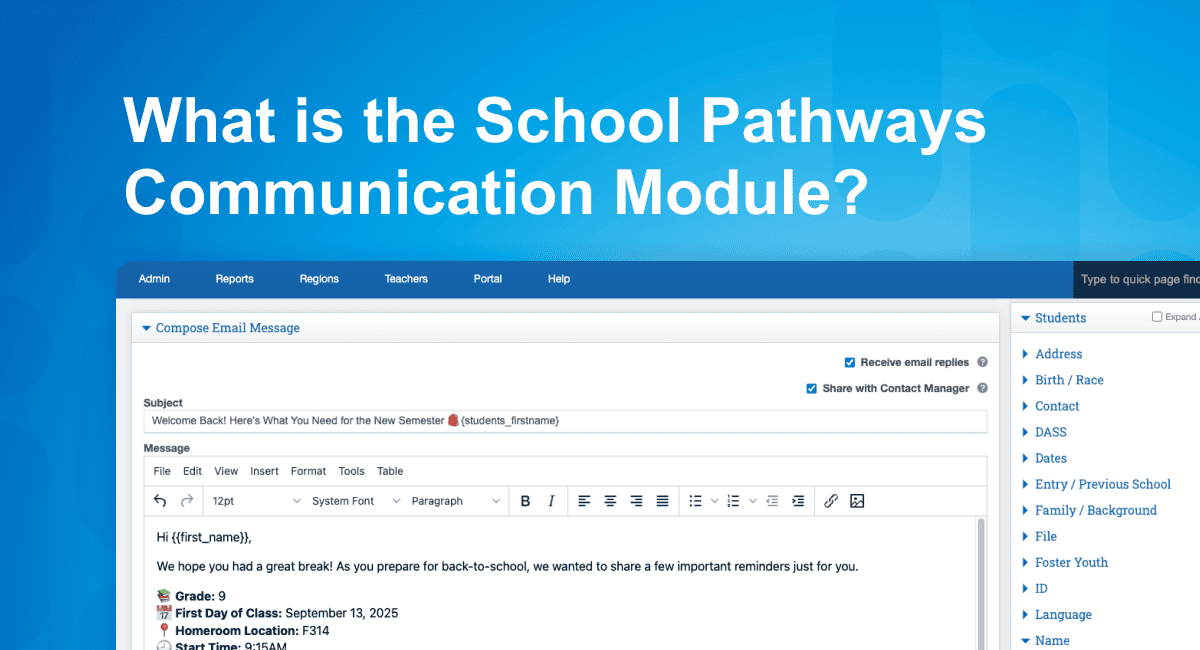Maintaining full enrollment ensures charter schools have the necessary resources to operate effectively and with the flexibility to meet families’ needs over time. But achieving full enrollment requires a top-notch student recruitment plan.
An effective way for educators to reach their enrollment targets is by taking a data-driven approach to understand their applicant pool. Here, we’ll take a closer look at why and how educators can use data to make recruitment decisions.
The Importance of Data in Attracting and Recruiting Students
Having a steady stream of incoming students allows for stability, clear planning, and accurate budgeting from staffing to student programming. When schools fall short of hitting their enrollment targets, it reduces their funding pool, shaking the foundation for success in various aspects of the school’s operations.
A data-driven approach can clarify and sharpen your recruitment efforts. It further allows educators to have an accurate, timely, and relevant understanding of prospective students’ needs and preferences over time. At the same time, educators can ensure a more personalized and effective outreach strategy.
Consider your data through the lens of past, present, and future:
- Looking at current enrollment numbers and the demographics of your existing student body can give you a clear sense of how recruitment efforts have been successful in the past.
- Understanding what is driving student recruitment, such as applicant demographics, locations, and competing school choices in your recruitment area, gives you an understanding of the present forces at play.
- Determining trends in enrollment based on historical data and predicted demographic shifts allows you to make an accurate assessment of future enrollment needs.
Taken together, these data points allow you to make informed choices and respond effectively to applicant needs, giving you much-needed command in an educational environment that can often feel unpredictable.
Enhancing Student Recruitment Strategies With Applicant and Lottery Data
A thorough and robust data-capture process can enhance student recruitment strategies in many ways. From measuring applicant engagement to tracking your outreach to prospective families, strategic data use is one of the best tools at your disposal.
Your applicant and lottery data provide you with a broad overview of who is most interested in your programming. You can find out what special interests and ages are represented in your current student body, as well as what activities and programming are most successful. Ultimately, you can learn who is choosing to accept enrollment and who is not.
Let’s dive into what you can do with your applicant and lottery data to improve recruitment in the future.
Improve Program Offerings
One way you can use your data is to improve program offerings. Are there rising numbers of applicants interested in specific sciences, language immersions, or civic volunteer opportunities? Data ensures you have these answers to provide curricular options and activities that align with your families’ needs and interests.
Integrating family feedback or rank choice into your data collection will allow you to understand how options are performing and how they match across gender- or age-specific groups. You can use this information to expand your most popular offerings and create similar offerings to meet demand across other groups.
Identify Enrollment Bottlenecks
Positive feedback is great. However, it’s also worthwhile to look at data from families who have left the program or declined enrollment.
Be sure to include feedback collection in your follow-up process for exiting families. Use your lottery list data to reach out to those who declined offers and uncover their reasons. This information is invaluable for addressing unmet needs and improving future enrollment and retention rates.
Reach Potential Sibling Enrollees
Keeping siblings together offers families convenience and stability, so using your data to reach out to families with multiple children can be the easiest and most effective recruitment strategy.
When building school applications, include a field where families can indicate if the applicant has siblings. Make sure they’re applying as well by sending targeted outreach to families and encouraging sibling enrollment during events or tours. Additionally, consider offering priority enrollment to siblings of current students to provide an incentive for early acceptance.
Improve Language Accessibility
Ensure that language barriers don’t stand in the way of a family’s decision to choose your school.
Collect language information about your applicants and enrollees and identify those that are most commonly spoken in your community. Hire bilingual staff to assist with recruitment and ongoing family support. Additionally, translating application forms, brochures, and key sections of the website into the most commonly spoken languages within the community are simple steps that support the diverse linguistic needs of your community.
Identify and Address Gaps in Enrollment
Use your current enrollment data to identify current or foreseeable gaps in the student body. If you recognize gaps in specific communities, gender disparities, or uneven age distributions, you can address those proactively.
By hosting diverse mentorship programs, offering enrichment programs for advanced age groups, or teaming up with community clubs that serve diverse groups, you’ll ensure you have a balanced student body and that you are not overlooking any untapped applicant pools.
Keep Your Waitlist Engaged
Student waitlists offer a wealth of insights for your analysis. By examining the waitlist density, you can identify high-interest areas and focus your marketing efforts where they are most likely to succeed. Additionally, you can pinpoint areas or traits of lagging applications and refocus recruitment efforts to increase brand awareness and familiarity among these groups.
A waitlist can also be a powerful tool for recruitment — if you keep your members engaged. Use data to determine the best methods for communicating with waitlisted families, whether it’s by email, text, or even app notifications. The more timely and personalized your communications are, the more engaged and retained prospective students will be in the enrollment process.
Streamline Future Recruitment Efforts
Above all, a clear understanding of your current student body allows you to be strategic and intentional about future recruitment efforts.
Make sure to consistently perform data analysis on your current students’ demographics, geographical locations, interests, and goals. An ongoing and holistic view of past, present, and future trends can spark substantive insights. As a result, you can build and refine marketing campaigns and processes that help strengthen your school’s reputation and name recognition while addressing the needs of your community.
Maximize Charter Recruitment Success with Applicant and Lottery Data
Running a charter school is an involved, multi-faceted endeavor. While recruitment is key to your charter school’s stability and long-term success, it’s not always easy to allocate the time, staff, and training to make student recruitment run as smoothly as it could.
School Pathways is here to make the process seamless. Collect the information you need in a user-friendly, actionable format so that you can make data-driven recruitment decisions that get results with less effort and guesswork. We offer an integrated, comprehensive solution for charter schools that are built with data-driven policies and ease-of-use in mind. From the moment prospective families begin interacting with your school, you’ll be able to capture key information about their needs and interests and use it to build responsive, tailored solutions and recruitment efforts.
If you’re ready to learn more about School Pathways and how we can help make your student recruitment process easier and more effective, get in touch with us today.





